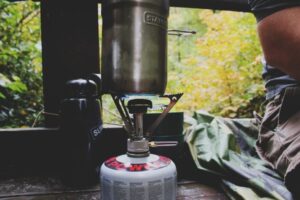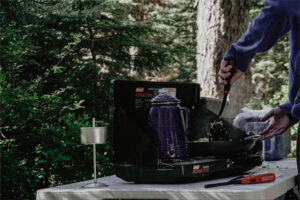 So we heard it right– you’re bitten by the backpacking bug? Awesome! This adventure into the wilderness promises fresh air, stunning scenery, and a chance to truly disconnect. But before you lace up your boots, gearing up properly is crucial. Think of it as building your own mini, mobile home for the trail. The right tools will keep you comfortable, safe, and ready for anything, turning your trip from a struggle into a smooth, unforgettable experience.
So we heard it right– you’re bitten by the backpacking bug? Awesome! This adventure into the wilderness promises fresh air, stunning scenery, and a chance to truly disconnect. But before you lace up your boots, gearing up properly is crucial. Think of it as building your own mini, mobile home for the trail. The right tools will keep you comfortable, safe, and ready for anything, turning your trip from a struggle into a smooth, unforgettable experience.
Let’s explore why beginner backpacking gear is essential and explore the must-have items for your next outdoor excursion.
First-timers, listen close: gear’s not glam, it’s your lifeline.
Why Backpacking Gear is Crucial for Beginners?
Here’s why beginner-friendly gear matters:
Comfort is king
A good backpack distributes weight evenly, preventing aches and pains. Sturdy boots support your ankles on uneven terrain, and a comfy sleeping pad turns the ground into a cozy haven.
Safety first
Be prepared for unexpected weather or minor mishaps. A headlamp illuminates the night, a first-aid kit soothes scrapes, and a water purification system ensures clean hydration.
Confidence boost
Knowing you’re equipped for anything empowers you to truly enjoy the trail. Focus on the breathtaking views, not the worry of a leaky tent or empty water bottle.
You’re miles away from your home, surrounded by towering trees and landscapes. Without the proper gear, your wilderness adventure could quickly turn into a challenging ordeal. Beginner backpacking gear isn’t just about comfort; it’s about safety, preparedness, and peace of mind. The right gear helps you to handle unexpected weather changes, rough terrain, and emergencies, allowing you to focus on the goal, which is peace of mind.
Who Can Use This Ultimate List?
Whether you’re a novice explorer embarking on your first backpacking journey or a seasoned outdoor enthusiast looking to refresh your gear collection, this comprehensive list has something for everyone. Designed with affordability and practicality in mind, these gear recommendations cater to backpackers of all experience levels.
Best Beginner Backpacking Gear List
1. Backpacking and Its 3 Essentials
· A Backpack
Your backpack is your lifeline on the trail, carrying everything from food and water to shelter and clothing. Look for a backpack that fits your torso length, has adjustable straps, and features multiple compartments for easy organization.
· A Quality Tent for Shelter
Your tent is your home away from home in the wilderness. Invest in a lightweight, weather-resistant tent that offers ample space for sleeping and storage. Consider factors like tent capacity, seasonality, and ease of setup.
· A Sleeping Bag
For an enjoyable backpacking experience, a good night’s sleep is crucial. Choose a sleeping bag that’s appropriate for the expected temperatures of your destination. Look for lightweight, compressible options with synthetic or down insulation.
· A Sleeping Pad
Don’t underestimate the importance of a comfortable sleeping pad. Opt for a lightweight, inflatable pad that provides insulation and cushioning against the hard ground. Consider features like R-value, thickness, and packability.
· A Pillow
While it may seem like a luxury, a compact camping pillow can significantly improve your sleep quality on the trail. Look for inflatable or compressible pillows that offer neck support and comfort without adding too much weight to your pack.
· A Backpack Cover
Keep your gear dry and protected from rain and moisture with a waterproof backpack cover. Choose a cover that fits snugly over your backpack and features durable, seam-sealed construction.
2. Clothing and Shoes
· Sweat-Absorbing Shirts
Stay dry and comfortable on the trail with moisture-wicking shirts made from breathable fabrics like merino wool or synthetic blends. Avoid cotton, as it retains moisture and can lead to chafing and discomfort.
· Leggings/Pants
Choose lightweight, quick-drying pants or leggings that offer freedom of movement and protection against sun exposure and insect bites. Look for options with UPF sun protection and reinforced knees for durability.
· Base Layer Clothing
Layering is key to regulating your body temperature in changing weather conditions. Invest in moisture-wicking base layers made from materials like merino wool or synthetic blends. Consider long-sleeve tops and bottoms for added warmth.
· Warm Hat and Gloves
Protect your head, ears, and hands from cold temperatures with insulated hats and gloves. Look for options made from fleece or thermal materials that provide warmth without bulk.
· Hand and Foot Warmers
Pack disposable hand and foot warmers for chilly nights or cold weather hikes. These portable heat packs provide instant warmth and comfort when you need it most.
· Heat-Trapping Shoes
Invest in sturdy hiking boots or trail shoes with good traction and ankle support. Choose footwear that’s waterproof and breathable to keep your feet dry and comfortable on long hikes.
3. Cooking Gear
· Backpacking Stove
Choose a lightweight, compact backpacking stove that’s easy to use and fuel-efficient. Consider options like canister stoves or alcohol stoves for their simplicity and reliability in the field.
· Fire Starter
Pack reliable fire-starting tools such as waterproof matches, a butane lighter, or a ferrocerium rod. Practice proper fire-building techniques and adhere to Leave No Trace principles when using open flames.
· Backpacking Pot
Opt for a durable, lightweight pot with a lid for cooking meals and boiling water. Look for pots made from aluminum or titanium for efficient heat distribution and easy cleanup.
· Pot Gripper
Ensure safe handling of hot pots and pans with a sturdy pot gripper. Choose a gripper with insulated handles and a secure grip for added safety.
· Cookware
Pack essential cookware such as utensils, plates, bowls, and cups made from lightweight materials like stainless steel or BPA-free plastic. Choose collapsible or nesting designs to save space in your pack.
· French Press Coffee Maker
Enjoy freshly brewed coffee on the trail with a portable French press coffee maker. Look for a durable, shatterproof design that’s easy to clean and pack.
· Camping Tea Kettle
Boil water for hot beverages and meals with a lightweight, durable camping tea kettle. Choose a model with a secure lid and heat-resistant handle for safe pouring.
· Tea Caddy
Keep your favorite tea blends organized and accessible with a compact tea caddy designed for outdoor use. Look for a waterproof, airtight container to preserve freshness.
· Folding Furniture
Create a comfortable campsite with folding tables and chairs that provide a stable surface for cooking, dining, and relaxation. Choose lightweight, collapsible designs for easy transport and setup.
4. Electronic Gear
· Device for Communication
Stay connected with a reliable communication device such as a satellite phone, two-way radio, or personal locator beacon (PLB). Ensure your device has adequate battery life and coverage for your intended destination.
· Torch or if Headlamp Well and Good
Illuminate your campsite and navigate trails after dark with a lightweight, hands-free headlamp or torch. Look for adjustable brightness settings and long battery life for extended use.
· Camera to Seal Memories
Capture breathtaking landscapes and memorable moments with a durable, waterproof camera designed for outdoor adventures. Consider factors like resolution, optical zoom, and durability when choosing the right camera for your needs.
· Tripod
Stabilize your camera and capture steady shots with a lightweight, portable tripod. Look for models with adjustable legs and quick-release mounts for versatility and ease of use.
· Charging Devices Better Not to Go Without Them
Keep your electronic devices powered up on the trail with a portable charging device or solar charger. Choose a model with multiple USB ports and fast-charging capabilities for added convenience.
5. Personal Essentials
· Toothbrush and Toothpaste
Maintain oral hygiene on the trail with a compact toothbrush and travel-size toothpaste. Opt for biodegradable options to minimize environmental impact.
· Toilet Paper
Pack biodegradable toilet paper in a waterproof bag for waste disposal during backcountry trips. Follow Leave No Trace principles and pack out used toilet paper in designated waste containers.
· Wipes
Stay clean and refreshed on the trail with biodegradable cleansing wipes. Choose wipes that are gentle on the skin and free from harsh chemicals or fragrances.
6. Medical Kit
Prepare a comprehensive medical kit that includes essentials such as adhesive bandages, gauze pads, antiseptic wipes, tweezers, pain relievers, and blister treatment. Customize your kit based on your medical history, destination, and activities planned.
7. Bear-Safe Outdoor Storage Bags
Protect your food and scented items from wildlife encounters with bear-resistant storage containers or bags. Choose durable, odor-proof options that meet regulatory standards for bear safety.
8. Trekking Poles
For stability and support, improve balance and reduce strain on your joints with adjustable trekking poles. Look for lightweight, collapsible poles with ergonomic grips and carbide tips for optimal traction on varied terrain.
9. Wildlife Safety Gear
· Bear Spray
Carry bear spray in bear country as a last resort for deterring aggressive wildlife. Familiarize yourself with proper usage techniques and safety precautions before venturing into bear habitat.
· Bug Repellent
Protect yourself from mosquitoes, ticks, and other biting insects with DEET-free bug repellent. Choose formulas that are safe for use on skin and clothing, and reapply as directed for maximum effectiveness.
FAQs
What gear to buy first when backpacking?
- Start with essential items like a backpack, tent, sleeping bag, and footwear before investing in specialized gear.
What are the big three items for backpacking?
- The “big three” refers to the most critical gear categories: shelter (tent), sleeping system (sleeping bag and pad), and backpack.
Is 40 too old to go backpacking?
- Age is not a barrier to enjoying outdoor adventures like backpacking. With proper preparation and physical conditioning, individuals of all ages can embark on backpacking trips.
Is a 50L backpack enough for backpacking?
- 50-liter backpack is suitable for shorter trips or ultralight backpacking endeavors. Consider the duration of your trip, your gear volume, and your personal comfort preferences when selecting a backpack size.
The Big Takeaway
With appropriate equipment and information, you can set out on an amazing backpacking adventure. Prioritize safety, comfort, and sustainability in your gear choices, and remember to respect the natural environment and leave no trace. Whether you’re exploring remote wilderness areas or scenic trails close to home, the adventure of backpacking awaits!





